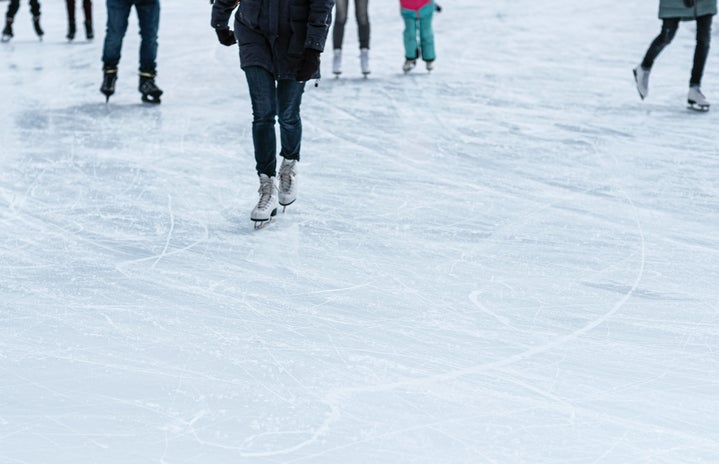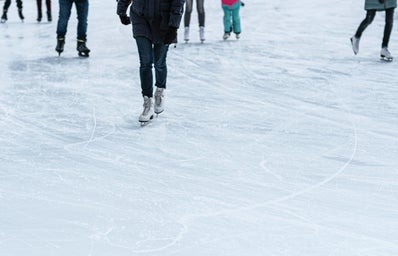The glitz, the glamour! But what does a score of 4.03 on a double Axel mean?
Winter Olympics season is underway, and as usual, figure skating remains one of the most popular events for all of us watching at home. For casual viewers, the nuances of the sport can be hard to decipher without a little guidance. So, for some pre-skating prep, let’s break down what these competitions are and what elements these athletes are performing on the ice.
- Who’s who?
-
There are four areas of competition skaters can compete in: men’s, women’s, pairs, and ice dance. Individual skaters compete in the men’s and women’s competitions, while pairs and ice dancers compete as a duo. Generally speaking, men’s, women’s, and pairs emphasize jumps and spins, while ice dance emphasizes choreographic skating skills.
- Men’s singles – jumps, spins, step sequence
- Women’s singles – jumps, spins, step sequence
- Pairs – jumps, spins, step sequence, lifts
- Ice dance – choreographic sequences, spins, lifts
These competitions are split into a short program, performed first, followed by a free skate the next day. As the names imply, short programs are the shorter of the two and require fewer elements than the free skate. In ice dance, the short program is called the rhythm dance.
The most visible element for differentiating between pairs and ice dance is the jumps. Pairs perform synchronized jumps, twist throws, and throw jumps. While you don’t need to know the difference between those yet, just know that there are NO jumps in ice dance.
Olympic figure skating is unique compared to other international skating competitions, because of the inclusion of the team skating event. This event features every discipline whose scores are totaled together and ranked 1-10, and the team with the highest number after ranking takes the gold.
- What’s What?
-
For this breakdown, let’s dive into singles skating. First up, jumps. Men perform quadruple jumps (quads) and triple jumps, while women (with some exceptions) execute triple jumps. These jumps are either solo or in combination, meaning they are done immediately after the completion of another jump for a higher score. The skater is required to perform and limited to a certain number of jumps in each program, so there is only one chance to perform each element in the routine.
- Flip (toe-pick takeoff)
- Lutz (toe-pick takeoff)
- Loop (blade takeoff)
- Salchow (blade takeoff)
- Axel (blade takeoff, front facing)
The most recognizable of all jumps is the Axel, which features the skater skating forward on one foot in their takeoff and then leaping into their jump. All other jumps have a takeoff where the skater is backward on one foot, then using the blade they are on or the toe-pick of the other foot to begin their leap.
To distinguish a flip and a Lutz, the two toe-pick assisted jumps, pay attention to the entrance of the jump. Because the Lutz takes off from an outside edge on the left foot, you can usually see the skater’s foot — which starts moving backward in a straight line — slide to the right immediately before the takeoff. This looks like a small swivel of the body, compared to the flip jump (inside edge) where the skater is skating backward completely straight from entrance to takeoff. For great examples of Lutz’s, check out skaters Elizaveta Tuktamysheva and Nathan Chen.
For more information on jumps, check out this Atlantic article, complete with GIF examples, or this YouTube video for visual examples.
In addition to jumps, singles skaters must complete a step sequence. The latter refers to a series of turns and step movements in the program. This element most closely resembles dance for non-skaters and is used to show the skater’s control of their edges (edges of the blade) and their musicality (interpretation of the music). For beautiful step sequences, check out skaters Yuzuru Hanu and Carolina Kostner.
The final component of the program is the spins. Spins are performed in combination, moving from one form of the body to the next while continuously rotating. Spins that include a jump entrance or jump element are flying, such as the flying camel or the flying sit-spin. Watch the spins of Karen Chen and Bradie Tennell.
- How are they scored?
-
Each element: jump, spin, or step sequence has a base value, or a certain number of points if completed. The old scoring system where a skater earned a score of 0 to 6 for the whole program was phased out in 2006 after the 2002 Winter Olympics Scandal. A few points can be added or deducted off of that base value depending on how well the skater performed the element. All these points are added together, and the skater with the most points wins.
Who are you rooting for at Beijing 2022?
Want to keep up with HCBU? Make sure to like us on Facebook, follow us on Instagram, check out our Pinterest board, and read our latest Tweets!


